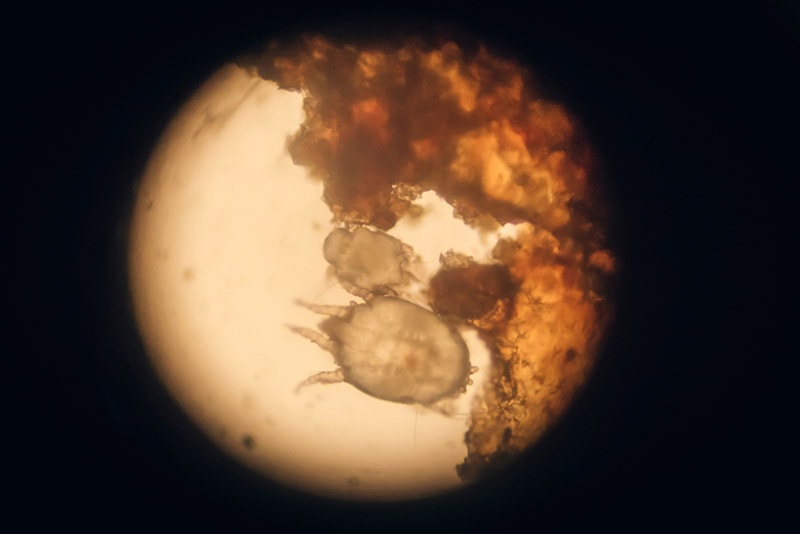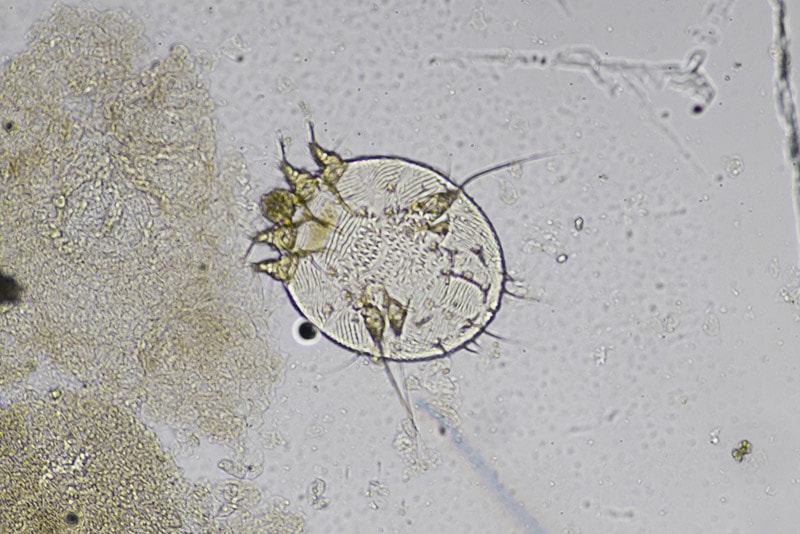What Do Scabies Look Like Under a Microscope? The Interesting Answer!
Last Updated on

Few skin conditions are as aggravating as scabies. The intense itching will not only disturb your sleep and waking hours, but it can also leave you vulnerable to secondary bacterial infections. The mite Sarcoptes scabiei causes these symptoms. While it may resemble other conditions in its early stages, it develops telltale signs that make it evident that it’s a parasite infestation.
Your doctor may order skin scraping to confirm a diagnosis.1 A lab technician may spot the mites themselves, their eggs, or fecal matter under a microscope. The mites are arachnids, just like spiders. You’ll see its two-part body and eight legs under magnification. It may appear prehistoric looking when viewed this way. However, there’s no mistaking what it is.

Diagnosis & Treatment
Viewing a skin scraping under a microscope is almost a formality because of the visible signs on a person’s skin. The mite digs short furrows, which are evident because of their raised, red appearance. Of course, the unrelenting itching is another giveaway. It is worth noting that less than 20 parasites are typically present on a person,1 making identification of the mite more challenging.
One way to obtain a mite is with a needle inserted into one of the raised ridges.
- Soles of feet
- Knees
- Waist
- Inner forearms
- Between the fingers
A simple saline mount is an excellent way to spot them. If the scraping contains one, the chances are you’ll see the mite moving. It’s usually visible at 40x power. The parasites are oval-shaped, with appendages present in the front part of their body. There are also hair-like structures protruding from their hind end.
Once your doctor confirms the diagnosis, you can begin treatment with a prescription topical lotion and sometimes Ivermectin if it isn’t responsive. Bear in mind that the itching will likely continue long after the parasites are gone.
You may need additional treatment if a bacterial infection develops. It may involve another topical ointment and antibiotics to get it under control.

Scabies vs Mange
Scabies aren’t confined to people. Animals can also get it. However, veterinary medicine calls this condition mange. You can get this skin condition from your dog or cat. However, it’s usually not serious since they are different parasites and won’t reproduce on humans. Nevertheless, it’s just as uncomfortable for pets as it is for people.
The parasite your dog or cat may get is a different variant of the human form. It prefers these animals as hosts, which is why it won’t cause people many problems. All forms are contagious, making prompt treatment necessary.

Final Thoughts
Scabies are an irritating and potentially serious condition in people. Its incessant itching is sure to make you uncomfortable, to say the least. Fortunately, it’s relatively easy to treat once your doctor diagnoses it. A skin scraping will tell them everything they need to know to start your treatment immediately. Early diagnosis is vital to stop the itching and restore your quality of life.
Featured Image Credit: ValentinaPopovic, Shutterstock
Table of Contents
About the Author Chris Dinesen Rogers
Chris has been writing since 2009 on a variety of topics. Her motto with all of her writing is “science-based writing nurtured by education and critical thinking.” Chris specializes in science topics and has a special love for health and environmental topics, and animals of all shapes and sizes.
Related Articles:
What Is the Best Binocular Magnification for Hunting? Optical Features Explained
Can You Use Binoculars to Look At Stars? How to Choose the Right Pair
How to Clean a Refractor Telescope: Step-by-Step Guide
How to Clean a Telescope Eyepiece: Step-by-Step Guide
How to Clean a Rifle Scope: 8 Expert Tips
Monocular vs Telescope: Differences Explained (With Pictures)
What Is a Monocular Used For? 8 Common Functions
How to Clean a Telescope Mirror: 8 Expert Tips
